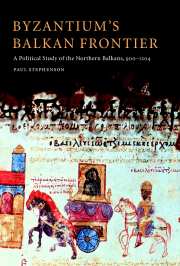Book contents
- Frontmatter
- Contents
- List of maps and figures
- Preface
- A note on citation and transliteration
- List of abbreviations
- Introduction
- 1 Bulgaria and beyond: the Northern Balkans (c.900–963)
- 2 The Byzantine occupation of Bulgaria (963–1025)
- 3 Northern nomads (1025–1100)
- 4 Southern Slavs (1025–1100)
- 5 The rise of the west, I: Normans and Crusaders (1081–1118)
- 6 The rise of the west, II: Hungarians and Venetians (1100–1143)
- 7 Manuel I Comnenus confronts the West (1143–1156)
- 8 Advancing the frontier: the annexation of Sirmium and Dalmatia (1156–1180)
- 9 Casting off the ‘Byzantine Yoke’ (1180–1204)
- Conclusions
- Bibliography
- Index
1 - Bulgaria and beyond: the Northern Balkans (c.900–963)
Published online by Cambridge University Press: 25 August 2009
- Frontmatter
- Contents
- List of maps and figures
- Preface
- A note on citation and transliteration
- List of abbreviations
- Introduction
- 1 Bulgaria and beyond: the Northern Balkans (c.900–963)
- 2 The Byzantine occupation of Bulgaria (963–1025)
- 3 Northern nomads (1025–1100)
- 4 Southern Slavs (1025–1100)
- 5 The rise of the west, I: Normans and Crusaders (1081–1118)
- 6 The rise of the west, II: Hungarians and Venetians (1100–1143)
- 7 Manuel I Comnenus confronts the West (1143–1156)
- 8 Advancing the frontier: the annexation of Sirmium and Dalmatia (1156–1180)
- 9 Casting off the ‘Byzantine Yoke’ (1180–1204)
- Conclusions
- Bibliography
- Index
Summary
For most of the tenth century Byzantium was the second power in the Balkans. The Bulgarian empire reached it fullest extent during the reign of Tsar Symeon (894–927), when its borders ran within miles of Thessalonica, in this period Byzantium's second city, and Dyrrachium (modern Durrës), the Adriatic port and gateway to the great land route called the Via Egnatia. Byzantine authority in the Balkans was restricted to Greece, Thrace, and a strip of land between the Rhodope mountains and the Aegean coast, including the administrative district (thema) of Macedonia. The border of Symeon's empire was marked by the erection of inscribed boundary stones. This frontier, as a line of political demarcation, was recognized by both Bulgaria and Byzantium in bilateral treaties.
SYMEON'S BULGARIA, 894–927
It has generally been maintained, not least in the excellent histories written in English of tenth-century Byzantium and Bulgaria, that for most of his reign, and certainly from 913, Symeon was intent on establishing himself in Constantinople, from which he would rule a combined empire as emperor of the Romans and Bulgarians. However, his efforts to establish a new capital at Preslav, and the extensive and expensive building projects therein, suggest that his principal interests lay north of the Haemus (Balkan) mountains.
- Type
- Chapter
- Information
- Byzantium's Balkan FrontierA Political Study of the Northern Balkans, 900–1204, pp. 18 - 46Publisher: Cambridge University PressPrint publication year: 2000



